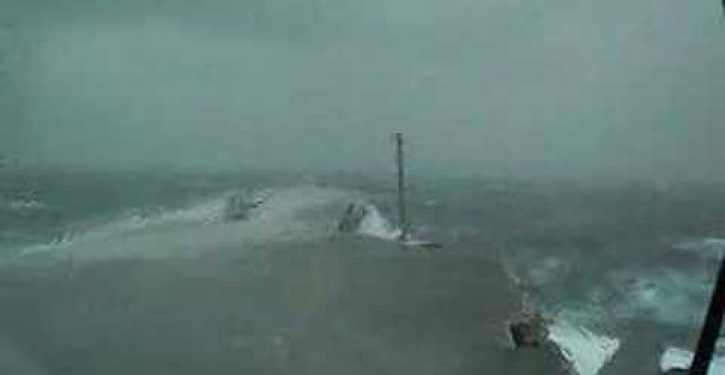
The Russian carrier Admiral Kuznetsov has been making a bit of a name for herself, belching and smoking her way through the English Channel (last Friday) as she heads for the Mediterranean Sea.
Some of Russia’s warships tend to do that (the belching and smoking thing). Age is not the only issue; as warships go, Admiral Kuznetsov isn’t that old. America’s and other elite navies have quite a few ships that are older. It’s more a matter of the type of propulsion and the condition in which the engines are kept.
So there’s some fun being made of Admiral Kuznetsov on social media.
Will this presidential election be the most important in American history?
But that doesn’t stop Western Europeans from making a big deal of the Russian carrier’s transit. Ships and patrol aircraft are keeping track of her. News agencies are going out in helicopters and cruise boats to get photos and video. Interested citizens have been lining up on the shores to catch a glimpse of her.
An armed and restive Russia is sending her mightiest warship to the Med.
The local frisson of both excitement and concern makes a sharp contrast with the quizzical reaction an American carrier sailor is likely to have. That reaction starts with looking at the footage of Kuznetsov in the Channel, and asking, “Um, where are the aircraft?”
Most of the images and video clips show the ship with two fighters on alert, and a helo to port of the tower, ready to get airborne for whatever purpose necessary (rescue, plane guard). One additional fighter is visible directly aft of the tower in some of the footage, with wings folded.
During the Channel transit, there’s nothing else on the flight deck (other than service vehicles). If you look closely at the video below, you’ll see that additional helicopters are hunkered down inside the hangar bay, which presumably is where the other fixed-wing aircraft are too.
https://www.youtube.com/watch?v=vnPDhnJy2JY
Basically, to pull no punches here, that’s not how a real aircraft carrier does it. It’s not clear why Kuznetsov pulled everything inside for the Channel transit. It’s not like the airwing is a secret she needs to keep. Traveling with an airwing is kind of the point.
Some of it was quite visible during the carrier’s Norwegian Sea transit, when she conducted flight ops before entering the Channel approaches.*
#Russia 'Admiral Kuznetsov' carrier group departure to East Mediterranean #Syria captured by #Norway AF P-3 pic.twitter.com/klB4P8RBTw
— Joseph Dempsey (@JosephHDempsey) October 17, 2016
#Russia carrier 'Admiral Kuznetsov' reportedly abandons published 19-21 Oct flight training NOTAM https://t.co/VNYO8qVczB pic.twitter.com/5FHVPctcZI
— Joseph Dempsey (@JosephHDempsey) October 19, 2016
The weather certainly doesn’t seem to be a factor. It should have to get a lot worse than it is, to justify moving all the aircraft into the hangar bay.
Maybe Russia was trying to signal that she meant no harm, with her transit through the Channel? Maybe she wanted to convey a message of extra-special defensiveness and peaceful intent? That would fly in the face of everything else Russia’s been doing for the last two years, and for that reason alone seems very unlikely. If Putin really wanted to convey such a message, he’d send the carrier down the west side of the British Isles, instead of putting it through the Channel.
No: we really have to conclude that the Kuznetsov transit posture through the English Channel is both provocative and incongruously furtive (or perhaps paranoid).
Before commenting on the difference political will makes, it’s worth taking a moment to compare this with how U.S. carriers do it.
Here’s one making a typical transit near the Strait of Hormuz – where every ship that passes through is under more concentrated threat than almost anywhere else on the planet. (We’ll except the Strait of Taiwan from that reckoning.)

Here’s an interesting shot or two of USS Theodore Roosevelt (CVN-71) making a stop in the UK in 2015. Granted, this was a friendly encounter from the outset, and the venue is the main naval base of one of our closest allies. Having practically the entire airwing on the flight deck is something arranged for the port visit, because the folks love it and it’s great PR and does honor to our friends in the UK.
But look at this image, and at the one of the SOH transit. The SOH transit image is of the carrier at work, coming through a dangerous chokepoint, and there are still lots of aircraft all over the flight deck.


Weather doesn’t force all the aircraft inside, for the most part, on a U.S. carrier.

Now and then, of course, it does.
Being in an unfamiliar location, with weather? Not so much. Here is USS George Washington (CVN-73) going through a choppy, wind-torn Strait of Magellan – some of the perpetually roughest seas on earth, and something very few American Navy sailors ever get to do.

Sure, Kuznetsov is a smaller carrier with a shallower draft. But she’s not a flat-bottomed tub. She’s built to ride the waves.
She’s making good speed in the Channel, as indicated by her wake and tower of smoke. But a U.S. carrier certainly doesn’t have to tuck the airwing down below to make her best speed (which is substantially higher).

There are, naturally, some maneuvers it’s best to practice without the airwing embarked.

And there are things you have to clear the flight deck to do, such as washing the flight deck down, and performing maintenance on it.
But tooling around the globe 24/365, in weather, chokepoints, and the threat envelopes of regional forces, U.S. Navy carriers just keep on working, with their airwings where airwings are supposed to be.
https://www.youtube.com/watch?v=HudI21ElqXU

Now for the unpleasant part. The U.S. Navy may know from carriers. But having ten of them, and operating them at a level above everyone else, doesn’t mean squat, if our national will is uncertain, and we can’t generate sustained combat power from more than two, maybe three carriers at a time.
Because of defense budget constraints (partly but not entirely from sequestration), which have cut badly into maintenance and training over the last five years (e.g., here), our carrier force is at a very low ebb of readiness. More than three may be underway at a given time, but most of the time now, we can’t keep more than two on full-readiness, full-length – 7-month – national-security-tasking deployments.
The Navy had to redefine its readiness criteria to get to news that good. Here is the key sentence from a U.S. Naval Institute summary of the Navy’s new readiness plan in January 2016:
Under [the Optimized Fleet Response Plan, or OFRP] the Navy will operate under a supply-based model rather than a demand-based model – giving the combatant commanders only as much presence as the service can generate without over-taxing the fleet.
So what the Navy can provide across the board, with the carriers and airwings as with other assets, is not “what the warfighters need,” but “what fits the realities of the budget.”
That’s where we are today.
Within the past year, we’ve had gaps in carrier coverage in the Middle East. We keep a carrier at full readiness in the Far East on a near-continuous basis, but we’ve recently had periods of less than two carriers available for full-time, full-readiness presence, with resulting gaps for the CENTCOM region. And the Navy expects that to happen again. It’s been a long time now, moreover, since we kept a routine carrier presence in the Med.
So for all our prowess in terms of technology and skill, you’re wrong if you think we can just swat combat problems like flies with our carrier force. Russia’s one carrier may belch smoke and hide her aircraft in a weird manner during transits, but Russia can actually put one off Syria right now, without shorting another national security commitment. With our ten carriers and our league-of-our-own carrier chops, we can’t.
This loss of real capability on our part maps back to the same reason John Kerry and his frequent bleatings about ceasefires lack credibility. Carriers are marvelous things. But they and their airwings take upkeep, and – like guns – they do only what people tell them to.
National power starts with will, not with weapons. The common vacuum that explains our current situation, with Russia dictating the terms of the fight in Syria, and Iran having her way with Iraq, while the American military struggles to execute a grab-bag of collateral tasks on a shoestring, is the vacuum of national will at the very top. It’s not accidental that Russia, showing will where America isn’t, has Europe goggle-eyed at her smoke-belching carrier.
Without will, a carrier is just a really big hunk of metal.
Here are the pictures on that.

* The English Channel is an international strait in which shipping has the right of innocent passage, which means the Russians can’t conduct anything but defensive or emergency air operations there. They can’t conduct routine carrier flight ops, as if they were in the open ocean. For part of the transit, they’re in the territorial seas of Britain and France.
But there is no need to stow all your aircraft down below to conduct innocent passage. You just keep them on deck and don’t fly them. See the U.S. carrier posture going through the Strait of Hormuz.






